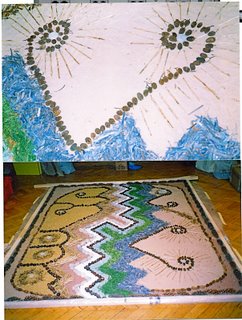 - inviting new readers
- inviting new readersThe creation of the Butterfly rangoli ( please see post 2) was based on the use of South Asian techniques and materials.
The 'rangoli' on the right was created by Sue Gande by using stones, twigs, coloured saw dust, sand, coloured woodchips and short grass cuttings to create her own abstract design. The top half of the picture shows the detail of the righthand side of the main work, where a 'v' shaped pattern is completed by two 'eyes'.
This is a large piece of work but shows common use of the floor as a base for the work, with careful use of a pattern which is then filled in with different materials than the Indian rangoli, on which this is based.
Other work created by our artists will show the use of grasses, sticks, stones, twigs and other materials found in a forest to create work that is similar to the work of the famous artist Andy Goldsworthy.
Further examples of floor based work can also be found in the website. Please see www.ephemeralarts.com Many communities use natural materials to create patterns on the floor. These designs are then used for a specific purpose and after the festival or celebration they are destroyed.
This is also a good time to add a few comments on how the other areas of ephemeral arts are equally exciting. The questions that I want to raise are:
- How will further additions to to this site benefit the range of people for whom it is intended?
- How can we help to develop networks and promote further information sharing?
- How can we promote the work of other artists who are not known to us?
- What specific input do teachers want from us to help them connect these ideas with the National Curriculum?
More about all these questions in the next few posts!


